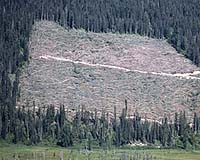| . |  |
. |
Paris (AFP) June 5, 2009 Fixing deforestation, preserving peatlands and ending reckless agricultural methods could be a major weapon in tackling climate change, the UN Environment Programme (UNEP) said on Friday. Biological systems, if responsibly managed, can absorb billions of tonnes of the dangerous carbon gases that fuel the greenhouse effect, the agency said in a report coinciding with World Environment Day. Trees and plants suck in carbon dioxide (CO2), the principal greenhouse gas, through photosynthesis. But this natural "sponge" is being damaged by deforestation and agricultural use, which releases the stored carbon to the air. Around 20 percent of annual greenhouse-gas emissions are imputable to logging, farming and burning of peatlands, according to scientists. UNEP Executive Director Achim Steiner said major countries had earmarked tens of billions of dollars in investments in carbon capture and storage technology, by which CO2 is siphoned off at power stations and then pumped underground or under the sea. "But perhaps the international community is overlooking a tried-and-tested method that has been working for millennia -- the biosphere," he said. "By some estimates, the Earth's living systems might be capable of sequestering more than 50 gigatonnes [50 billion tonnes] of carbon over the coming decades with the right market signals." The report touched on areas that are up for debate in talks to craft a new global pact on climate change. The accord, scheduled to be sealed in Copenhagen in December, will be take effect from the end of 2012. Separately, a study published in a science journal said the future pact, by incorporating an innovative mechanism, could deal a blow to tropical deforestation while also preserve precious biodiversity. The paper looked at the scenarios by which this proposed mechanism, called Reduce Emissions from Deforestation and forest Degradation (REDD), could work. Under REDD, countries that conserve their tropical forests and tackle deforestation would earn credits for reduced emissions. These credits would be sold on an international carbon market, or compensated through an international fund. But REDD is making slow progress in the UN talks, amid worries about its cost and how it would work in practice. The paper, published in the journal Conservation Letters, looked at how REDD could apply in the case of 3.3 million hectares (8.25 million acres) of forest in Indonesia's Borneo that is threatened by planned palmoil plantations. If CO2 credits could be sold for 10-33 US dollars per tonne, it would be profitable to keep the forest rather than clear it for oil palm, according to the study, lead-authored by Oscar Venter, a biologist at the University of Queensland in Australia. Conserving the forest at the same time would prevent 2.1 billion tonnes of carbon from entering the atmosphere and also preserve the habitat of orangutans, pygmy elephants and other threatened species. "Payments made to reduce carbon emissions from forests could also be an efficient and effective way to protect biodiversity," said Venter. Share This Article With Planet Earth
Related Links Forestry News - Global and Local News, Science and Application
 Alarm raised over forest plan to fight climate change
Alarm raised over forest plan to fight climate changeBogor, Indonesia (AFP) June 2, 2009 An ambitious plan to fight climate change by making polluters pay to preserve forests has come under a cloud, with some environmentalists calling it unworkable and dangerous. The plan, known as Reduced Emissions from Deforestation and Degradation (REDD), is being pushed as a key element for a new global agreement to fight climate change after the Kyoto Protocol expires in 2012. ... read more |
|
| The content herein, unless otherwise known to be public domain, are Copyright 1995-2009 - SpaceDaily. AFP and UPI Wire Stories are copyright Agence France-Presse and United Press International. ESA Portal Reports are copyright European Space Agency. All NASA sourced material is public domain. Additional copyrights may apply in whole or part to other bona fide parties. Advertising does not imply endorsement,agreement or approval of any opinions, statements or information provided by SpaceDaily on any Web page published or hosted by SpaceDaily. Privacy Statement |